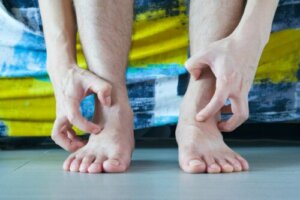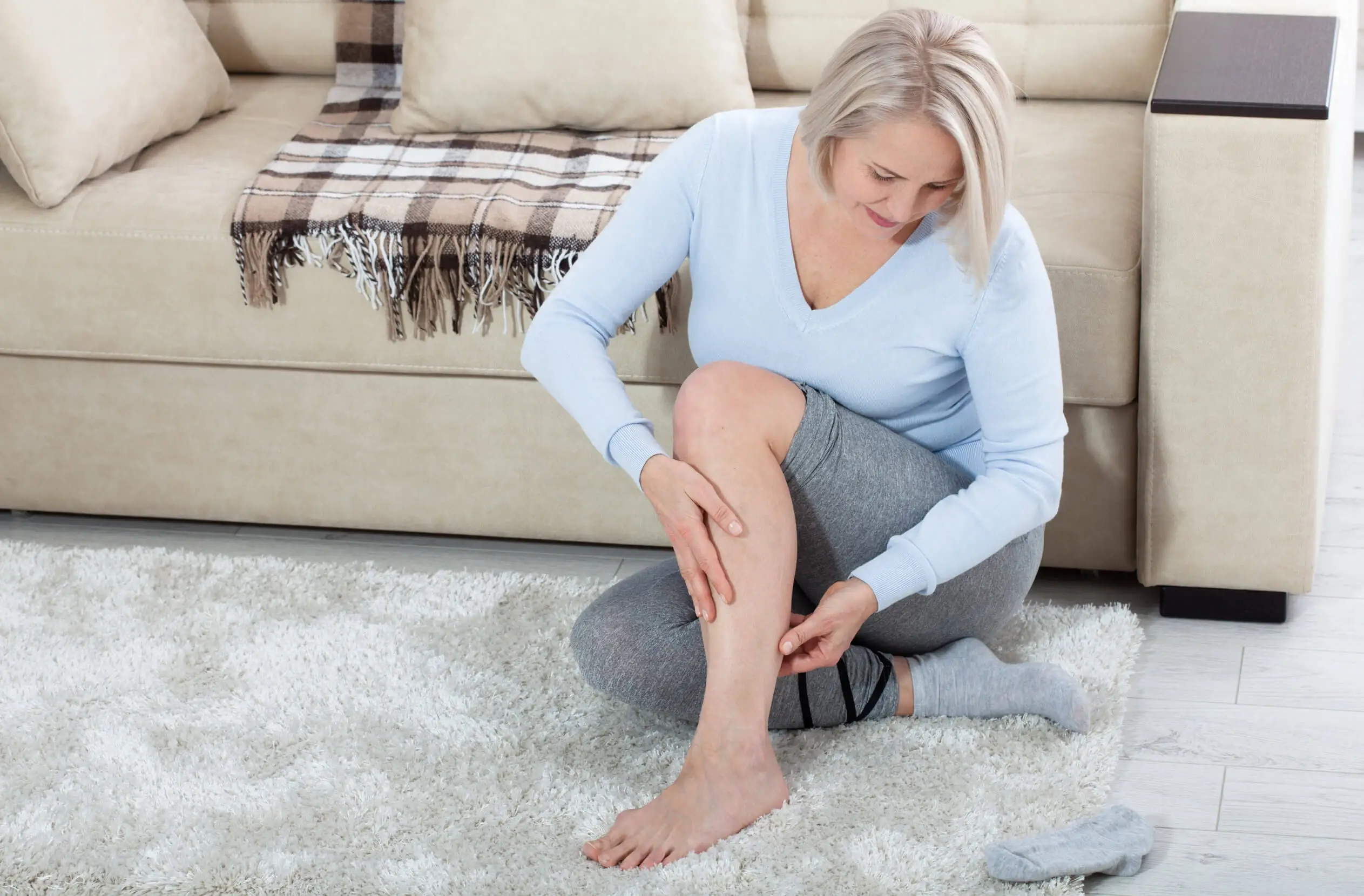10 Common Causes of Itchy Legs and What to Do About Them


Written and verified by the doctor Maryel Alvarado Nieto
Itching is a frequent and annoying problem in older adults. It can appear for many reasons, and, even though it can be a benign and easy-to-manage disorder, it’s sometimes due to a more serious medical disorder that requires medical attention. For this reason, it’s necessary to know the main conditions that cause itchy legs.
The unpleasant sensation causes a constant scratching of the skin, which can cause wounds, scars and even infections of varying degrees. Likewise, itching or pruritus affects people’s quality of life by affecting concentration, productivity, and even sleep.
That’s why it’s a good idea to get to know some tips and treatment that have been shown to be effective in treating itchy legs. Let’s get to it.
1. Dry skin
In dermatology, dry skin is known as xerosis. It’s a skin disorder in which the most superficial layer of the skin (epidermis) is affected, decreasing its degree of hydration.
Although the causes of dry skin are multiple, they involve an alteration of the protective components of the skin’s natural moisture, giving it a rough, cracked and flaky appearance. In the end, it results in continuous and intense itching.
Several factors predispose us to suffer from xerosis, as the proportions in which the substances present in the epidermis should be maintained are modified. Because of this, the barrier function is impaired, allowing greater water loss through the skin surface.
Dry skin is the main cause of itchy legs in older adults, but it can appear at any age.
What can be done with dry skin?
To reduce itchy legs caused by xerosis, the key is to allow the skin to rehydrate. In order to do this, you’ll need to change some behavior that includes improving your diet.
In addition, experts recommend that you take short showers, use lukewarm water and non-irritating soaps. Similarly, the application of moisturizing lotions after bathing is useful, especially if it’s done on wet skin.
If these recommendations don’t work, then topical treatment can be used. However, this should contain the main substances involved in maintaining the degree of hydration of the skin, among which we find lipids.
Also, glycerol may be useful in order to manage itching or pruritus. Finally, the use of steroids should be a last resort, since their prolonged use causes skin atrophy.
2. Contact dermatitis
Another common cause of itchy legs is contact dermatitis or eczema. Here, the exposure of the skin to chemical substances or to some physical agent can lead to the appearance of different degrees of skin lesion.
In addition to itching, the affected area becomes red and vesicles, exudation and crusting may also appear, and these are painful.
What to do with itchy legs caused by contact dermatitis?
The main action to improve itchy legs is to avoid exposure to the irritant agent. However, it’s necessary to improve the condition of the skin, the treatment of which depends on the type of lesion observed.
The application of barrier ointments is recommended. The use of topical steroids for a few days also helps to decrease the underlying inflammatory process.
3. Insect bites on the legs
A frequent cause of itching is insects, whose bite triggers a local inflammatory process.
Treatment consists of the application of local cold and lotions containing calamine. However, prevention is also very useful.
As for the use of repellents, their daily application isn’t recommended, but they should be used during outdoor walks and trips to regions with mosquito-borne disease transmission.

4. Infections
When a skin injury occurs, the protective skin barrier is lost, allowing microorganisms that can cause infections to enter. For this reason, skin wounds should be kept clean, no matter how innocuous they may appear.
Although bacterial infections can cause itching, the main causative agents of itching are fungi, viruses, and some parasites.
Fungi on the legs
Superficial mycoses are another common cause of itching. The lesions are usually ring-shaped plaques, which may be single or multiple.
These have scaly, crusty edges, while the center of the lesion has the characteristics of the surrounding healthy skin. Treatment of these infections requires the use of antifungal agents.
Larva migrans cutanea
This parasitic infestation is produced when a nematode enters the skin and migrates through it, causing linear lesions with a meandering course, which progress day by day.
It’s frequent in tropical areas, being a rare cause of pruritus on lower limbs. Although it tends to go away on its own, the annoying sensation forces the use of topical treatment.
5. Itching in the legs due to blood circulation disorders
Circulation problems are very frequent in the elderly population. One of the symptoms that appear when there’s some degree of venous insufficiency is itching in the lower limbs.
A change in lifestyle is considered a useful action in the prevention of these conditions, including frequent physical exercise and smoking cessation. However, when clinical manifestations are already present, then it’ll be necessary to seek medical evaluation.
Read more here: Food that Improves Circulation: Eight Types
6. Diabetes and itchy legs
High blood glucose levels maintained over time lead to peripheral nerve damage, leading to diabetic neuropathy.
Affection of the sympathetic fibers leads to the absence of sweating in the lower limbs, generating an imbalance in the regulation of skin hydration. In addition to itching, the patient notices a sensation of coldness and burning.
Correcting blood glucose levels is the main therapeutic objective.
7. A sign of renal problems
Similarly, pruritus is the most frequent skin symptom in patients with renal failure and in those on hemodialysis. The origin of the itching is still uncertain, which has also made treatment difficult to establish.
Among the drugs that have shown the greatest effectiveness are neuromodulators, such as pregabalin and gabapentin. However, these drugs are tricky to use correctly.
8. Can other disorders be involved?
In addition, there are other causes of pruritus affecting the lower limbs. Some of these include the following:
- Obesity
- Hyperthyroidism
- Psychogenic origin
- Lichenoid amyloidosis
- Adverse effects of medications

9. Cutaneous B-cell lymphoma
In cutaneous lymphomas there’s a proliferative process of lymphocytes affecting the skin, although sometimes other locations may also be involved. One of these neoplasms is characterized by appearing on the leg, where a reddish or purplish mass is observed.
In some patients, the presence of this nodule doesn’t produce any symptoms, but in others it may be accompanied by pruritus. Medical evaluation should be a priority.
10. Can cancer cause itchy legs?
Itching may also be the manifestation of the presence of cancer in a location other than the skin. This constitutes a paraneoplastic syndrome, in which the tumor mass isn’t directly related to the symptoms in question.
Itchy legs without apparent cause may be the early expression of Hodgkin’s lymphoma or be a hidden solid tumor.
This is why a patient with pruritus should be carefully evaluated, especially if the symptom isn’t recent. Likewise, the search for other clinical manifestations is very useful in order to guide the diagnostic suspicion.
All cited sources were thoroughly reviewed by our team to ensure their quality, reliability, currency, and validity. The bibliography of this article was considered reliable and of academic or scientific accuracy.
- Barco, D.; Giménez, A.; Xerosis: una Disfunción de la Barrera Epidérmica; Actas Dermosifiliográficas; 99: 671 – 682; 2008.
- Valderrama, S.; Morales, A.; López, J.; Dermatitis por Contacto; Asociación Española de Pediatría; 2019.
- Piñeiro, R.; Carabaño, I.; Manejo Práctico de las Picaduras de Insecto en Atención Primaria; Revista Pediátrica de Atención Primaria; 17: 159 – 166; 2015.
- Gubelin, W.; De la Parra, R.; Giesen, L.; Micosis Superficiales; Revista Médica Clínica Las Condes; 22 (6): 804 – 812; 2011.
- Varela, C.; Varela, M.; Pascual, M.; Larva Migrans Cutánea: Diagnóstico de Sospecha y Tratamiento en Atención Primaria; Medifam; 12 (10); 2002.
- Aguilar, L.; Trastornos Circulatorios de las Extremidades Inferiores (I). Clasificación, Epidemiología, Fisiopatología, Clínica y Complicaciones; Offarm; 22 (9): 94 – 104; 2003.
- Morales, B.; Prurito y Diabetes: Pensar en un Mal Control de la Glucemia y la Posibilidad de Fallo Renal Secundario; Más Dermatología; 37: 19 – 21; 2022.
- Lebrun-Vignes, B., and O. Chosidow. “Corticoterapia local cutánea.” EMC-Pediatría 42.2 (2007): 1-9.
- Zeballos, P.; Garrido, A.; Blasco, P.; Lafuente, E.; Pinós, P.; Manifestaciones Cutáneas de la Diabetes; Medicina Integral; 38 (1); 36 – 42; 2001.
- Perea, María Elena Cárdenas, et al. “Larva migrans cutánea.” Dermatología Revista Mexicana 57.5 (2013): 398-400.
- Tercedor, J.; López, B.; Ródenas, J.; Prurito Urémico; Actas Dermosifiliográficas; 89 (10): 507 – 513; 1998.
- De Luca, D.; Enz, P.; Galimberti, R.; Pápulas Pruriginosas en las Piernas: Revista Hospital Italiano de Buenos Aires; 30 (1); 2010.
- Buenaventura, M.; Borrego, L.; Linfoma Primario Cutáneo B de Célula Grande Difuso Tipo Piernas Según la Nueva Clasificación de la OMS-EORTC. Dos Casos; Actas Dermosifiliográficas; 96 (9): 607 – 611; 2005.
- Castillo, Luis del, Daniel Quezada, and Carlos De Bernard. “Prurito y urticaria como manifestación cutanea del hipertiroidismo y de interes para el dermatologo y el internista.” Arch. argent. dermatol (1985): 35-8.
- Solórzano, A.; Ronderos, M.; Prurito. Parte I. Fisiopatología y Enfermedades Asociadas. Revista CES Medicina; 26 (2); 2012.
- Barete, S.; Ayoub, N.; Francés, C.; Chosidow, O.; Dermatosis Paraneoplásicas; Elsevier SAS; E-2-0722; 2004.
This text is provided for informational purposes only and does not replace consultation with a professional. If in doubt, consult your specialist.








